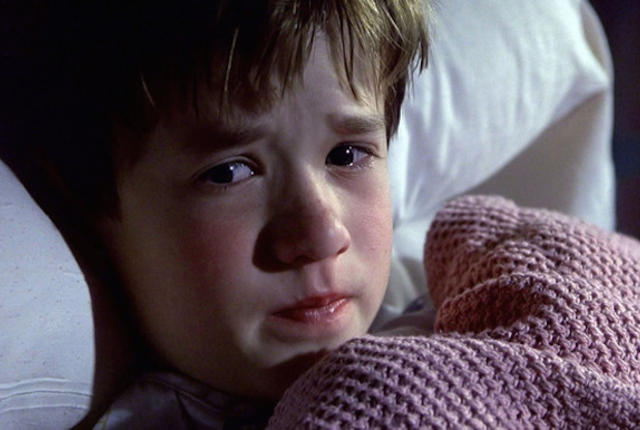 |
| Fig. 1 |
“The Sixth Sense” (1999) by M. Night Shyamalan centers on a child psychologist, Malcolm Crowe (Bruce Willis), and a young boy, Cole (Haley Joel Osment) at the mercy of apparitions. Yes, He can see dead people. “The Sixth Sense” is a special film, in that it contains, perhaps, one of the biggest twists in cinematic history.
To start, let’s deal with the big twist, wherein it is revealed that Malcolm is one of these apparitions. For, in the opening moments of the film he is shot by one of his old patients, who - it is hinted at (at least in the beginning as later on, the narrative breadcrumbs converge in a sort-of revelation as to the existence of spooks and spirits) - is suffering from the same problems as Cole. The film cuts to what we assume is a few months later, where Malcolm is healthy and back to work, and this transition is absolutely seamless. From then on, we occupy the false reality of Malcolm, where he himself is in denial that he has perished. But everything is presented to the viewer as if Malcolm is alive and well. This is made possible by a meticulous grasp on storytelling, matched with subtle foreshadowing that goes to serve the false reality displayed here. Everything, in that regard, is utterly believable until the final reveal, and is made so by parenting the main plot thread with Malcolm’s mini narrative concerning the growing gulf between himself and his wife (foreshadowed in the opening by the suggestion that he has a tendency to put work first) But, even without this thread, the Sixth Sense manages to build a silent dread around proceedings. This is indeed a film of subtle horror, Sian Cain writing for the Guardian reflects “The Sixth Sense isn’t a bloodfest or a whodunnit thriller: some may make the case it isn’t even a horror movie. But the quiet dialogue, the doe-eyed Osment and the sporadic yelp of violins create a tangible sense of dread that makes watching it an overwhelmingly freaky experience.” (Cain, 2014). It is definitely true to say of “The Sixth Sense”, that, overtly, it isn’t scary out and out scary. There are no gratuitous scenes concerning decapitation or trees that come to life and drag characters into the woods to do unspeakable things to them. The fear is generated by our own palpable fear of the unknown, and to an extent, things unseen. Masterfully, Shyamalan plays on our own natural fear of being alone, and this is seen in the immense melancholy of the spirits, who are eventually portrayed not as evil spectres, but real people with real failings, scared of being alone, scared at their own misgivings, wandering alone, absolutely confused, almost as if stuck with dementia and set loose on their own, Perceiving reality on their own terms stuck in neverending loops of past behaviours, not really aware of their own affect on their surroundings, Perhaps it is startling to merge a ghost narrative with that of mental degradation, but there are at least some similarities there, and it’s what goes some way at humanising this aspect of the narrative. It is certainly an element of what makes the emotional core of this film work, the extreme melancholy surrounding death and losing people. Something that haunts Shyamalan’s later works.
 |
| Fig 2. |
Dementia point aside, and going back to the story, which is layered so well, it seems that it dodges the revelation as soon as you start coming to the conclusion, everything seems thought of, or given a reason to be otherwise. Leah A. Cheyne, writing for offscreen.com mentions “The layering of relationships between the various characters, how those characters relate to their environment and each other, and how the spectator’s perception and acceptance of reality is called into question are each examined in this tightly structured narrative film” (Cheyne, 2003) For it is in buying into the notion that we are viewing events from Malcolm’s perspective, that the audience draws conclusions that crack under the revelatory nature of the finale. “The complex dialectical narrative structure leads the spectator into misreading the role that Malcolm plays within society. By placing him as one of the central protagonists, the spectator comes to understand part of the constructed film world from his perspective.” (Cheyne, 2003) And he himself is an unreliable narrator, which Cole directly states by saying the dead only see what they want to see, And in actuality we see everything from Malcolm’s eyes, everything Malcolm believes to be real.
Indeed, we are given brief moments of potential clarity, if, that is, we look hard enough. There is subtlety to be found within the production design itself; The main conceit here, being that the colour red is associated with spiritual activity, and examples where the cinematography tries to help us along the way, for instance, a telling slow zoom to Malcolm’s face in the moments after Cole reveals he can see dead people. In some ways, the subtle nature of the production design is highly reminiscent of Stanley Kubrick's “The Shining” (1980), which does it’s best to play with the reality of cinema and in particular, the space within the frame to confound the viewer (And there is a rather apparent link between these films in subject matter too, and the obvious “young boy with ability to talk to the dead” parallels). To say that this could be considered a spiritual (excuse the pun) successor to the Shining, wouldn’t be too far off the mark.
 |
| Fig 3. |
“The Sixth Sense” is a wonderfully evocative film, backed with emotional resonance seemingly pulled from Spielberg himself. It’s scary, on a base human level, playing on very personal fears of loss and loneliness. The ghosts aren’t scary because they’re ghosts. They’re scary because they’re us.
Bibliography
Illustrations

